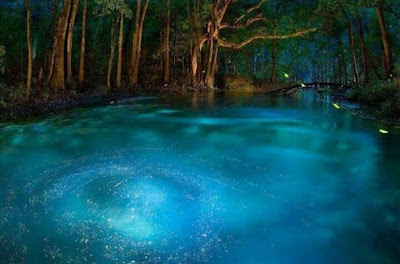In a clearing at a crossroads A Llanowauk warrior, bloody-eyed from overuse of stimulants harvested from Ancient caches, stands atop an overturned, giant, green stone head of a scowling god or demon. He loudly proclaims his strength and puissance at arms and calls for challengers. Despite well-worn state of his other possessions, his sword has an uncanny gleam.
On shores of the Lake of Vermilion Mists nearly naked female divers are inspecting their haul of rare ultramarine scintilla. Here and there their bodies bear what appear to be wave-like, mauve tattoos, darkened to the color of fresh bruises in the lake’s lurid, roiling glow, but are actually scars from the lash of urulu tentacles. The divers become tolerant to the hallucinogenic effects over time but not the pain, so they try to snatch the scintilla when the urulu are lost in courtship combat dances.
A gigantic fallen tree serves as a bridge over a deep ravine, but an arachnoid free manshonyagger makes its lair on the tree's underside and on occasion will catch and devour passersby. It cannot but heed its Ancient deep programming, so a human or humankin may command it, but only with the proper codes. The bottom of the gorge bears the possessions and bones of those who have passed before and not recalled them.
A domed inselberg rising from the forest is reputed to be haunted. Daily at solar noon, two identical angelic combatants, milk-white with prismatic-feathered wings, and large, bird-like eyes, grapple in the air above. Neither is ever able to overcome the other, and though their blows land with such force that onlookers claim they can feel shockwaves from them, there is never any sound. When the hour passes, they shrink and fade like shadows before the moving sun.
These are from this world.
These are from this world.













































